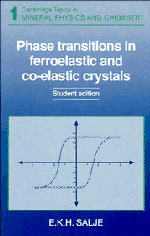Book contents
- Frontmatter
- Contents
- Errata
- Preface
- A brief guide for the reader
- 1 Introduction and some definitions
- 2 Ferroelastic and co-elastic phase transition
- 3 The Landau potential
- 4 The spontaneous strain
- 5 Coupling between the spontaneous strain and the order parameter
- 6 Macroscopic classification of ferroic and co-elastic crystals
- 7 Ferroelastic and co-elastic twin structures
- 8 Domain mobilities and elastic instabilities in ferroelastic and co-elastic materials
- 9 Specific heat anomalies and the excess entropy
- 10 Coupling between order parameters in ferroelastic and co-elastic crystals
- 11 Gradient coupling and strain modulations
- 12 Some aspects of the kinetic behaviour of ferroelastic and co-elastic crystals: an outlook
- References
- Appendix: An atomistic model for the Landau potential and the origins of the saturation effect
- Index
8 - Domain mobilities and elastic instabilities in ferroelastic and co-elastic materials
Published online by Cambridge University Press: 03 May 2011
- Frontmatter
- Contents
- Errata
- Preface
- A brief guide for the reader
- 1 Introduction and some definitions
- 2 Ferroelastic and co-elastic phase transition
- 3 The Landau potential
- 4 The spontaneous strain
- 5 Coupling between the spontaneous strain and the order parameter
- 6 Macroscopic classification of ferroic and co-elastic crystals
- 7 Ferroelastic and co-elastic twin structures
- 8 Domain mobilities and elastic instabilities in ferroelastic and co-elastic materials
- 9 Specific heat anomalies and the excess entropy
- 10 Coupling between order parameters in ferroelastic and co-elastic crystals
- 11 Gradient coupling and strain modulations
- 12 Some aspects of the kinetic behaviour of ferroelastic and co-elastic crystals: an outlook
- References
- Appendix: An atomistic model for the Landau potential and the origins of the saturation effect
- Index
Summary
The close connection between twin walls and kinks (or solitary waves) is discussed using a local potential of the Landau-Ginzburg type. Moving kinks define simple kinetic rate laws. Some algebra is necessary to derive expressions for the wall thickness and the wall energy in a second order and a tricritical phase transition. If the reader is more interested in the final results summarised in 8.3 than in their derivation and examples, he or she can ignore 8.2. In 8.4 the correlation between acoustic instabilities and twin wall formation is demonstrated using Al,Si disordered Na-feldspar as an example.
Solitary waves and a simple rate law
We have seen that domain structures can change rapidly when the thermodynamic condition of the sample, e.g. its temperature, changes even slightly. One example was the rapid formation of needle twins and their annealing. A second example is the lateral movement which can lead to the formation of periodic domain patterns. Snap-shots of such motions are shown in Fig.8.1 - 8.3.
In this chapter, the main physical features of these motions are described for a continuous, defect-free lattice. We shall discuss the strain profiles, the thickness and the energy of twin walls within the framework of the physical behaviour of solitary waves.
The starting point is the observation that the main characteristic feature of a co-elastic phase transition is the role played by the elastic interactions which act over long interatomic distances.
- Type
- Chapter
- Information
- Phase Transitions in Ferroelastic and Co-elastic Crystals , pp. 76 - 117Publisher: Cambridge University PressPrint publication year: 1991



